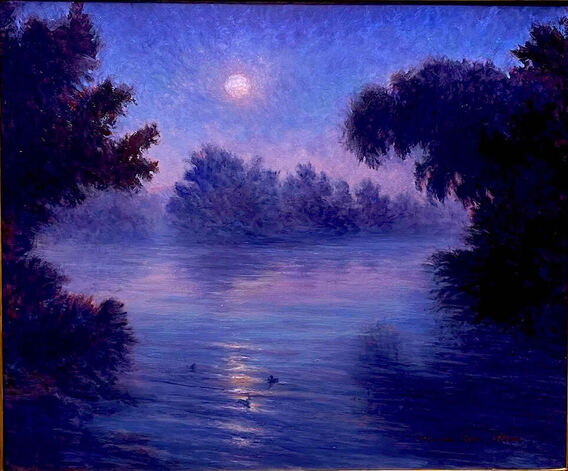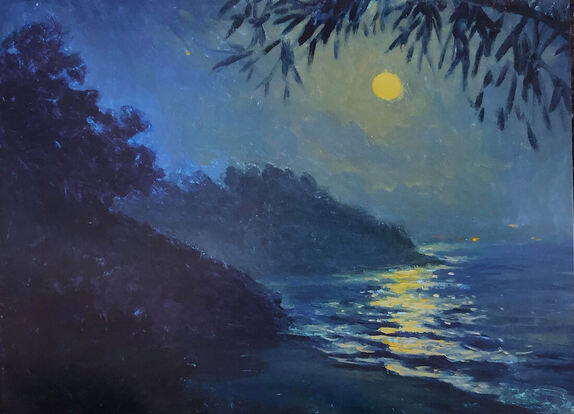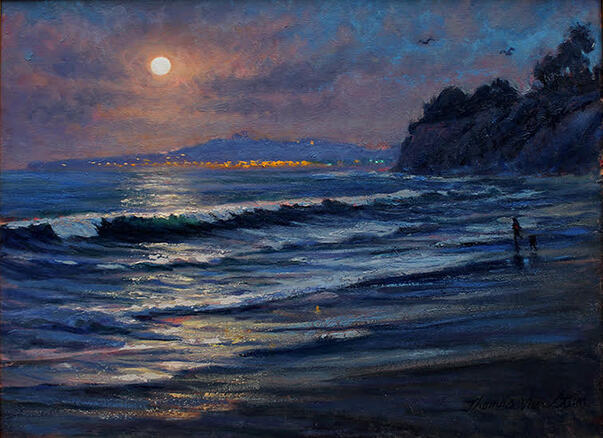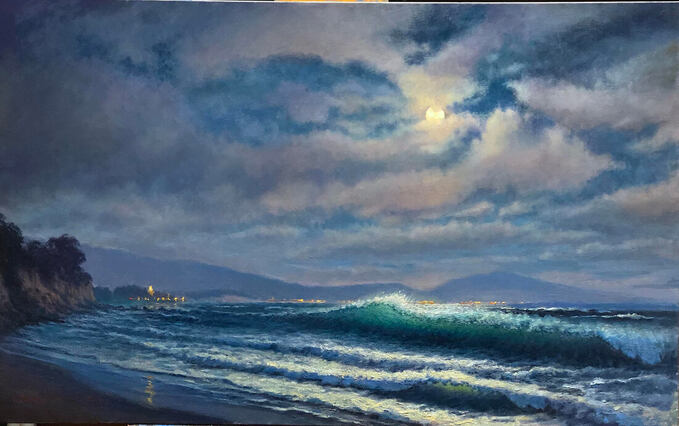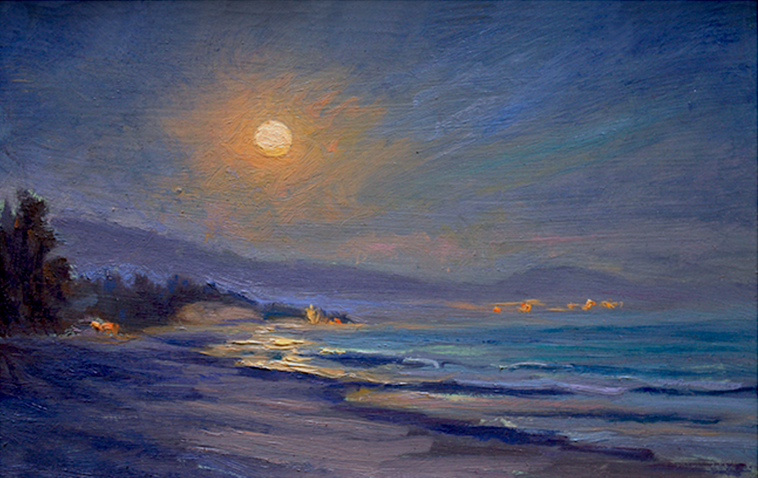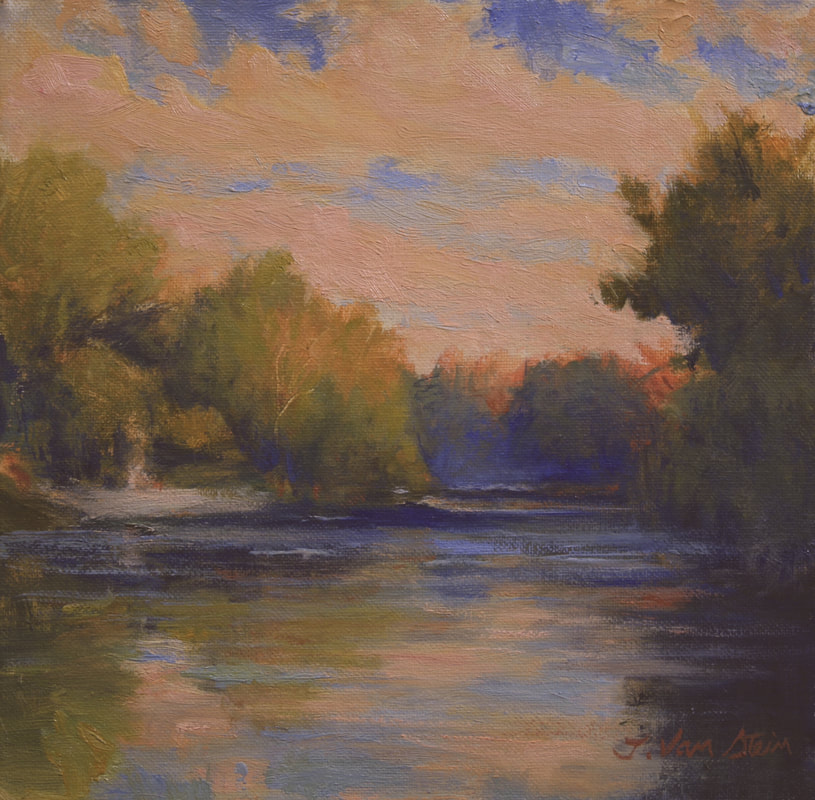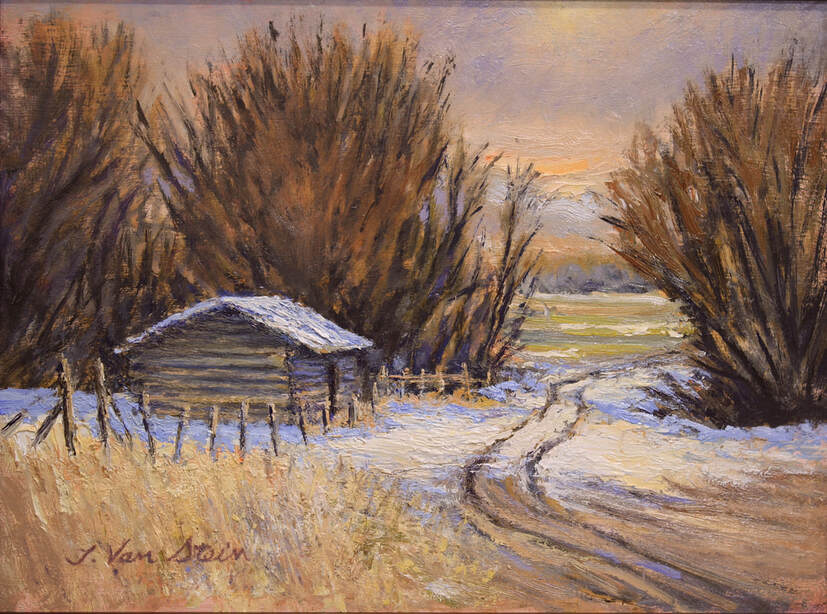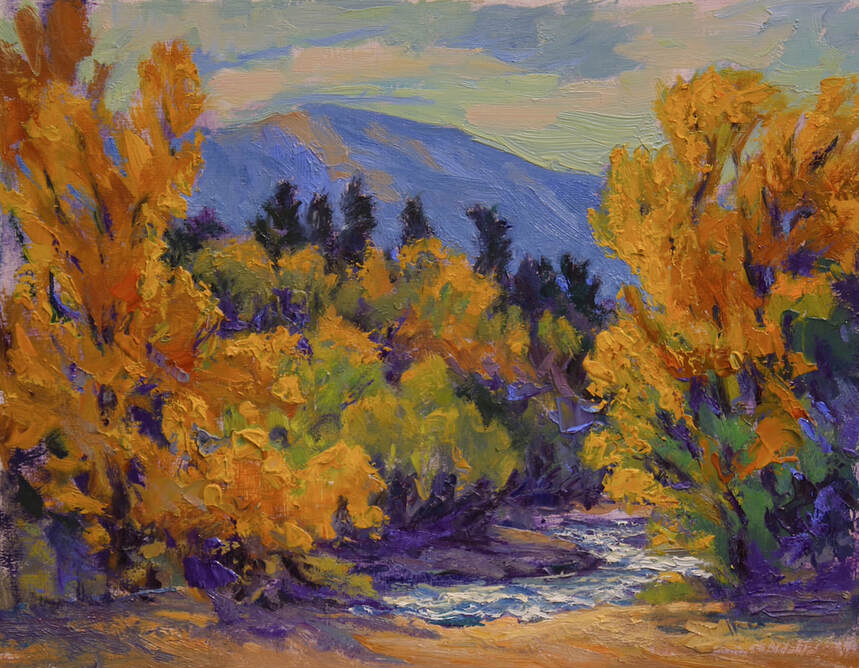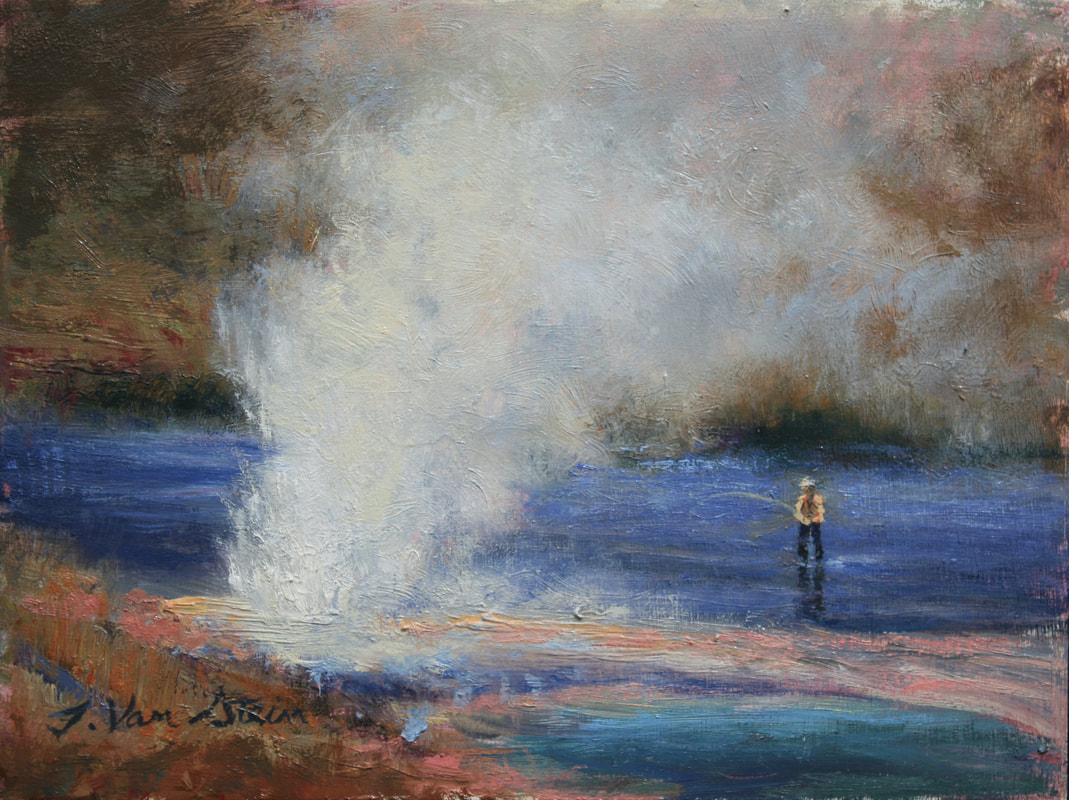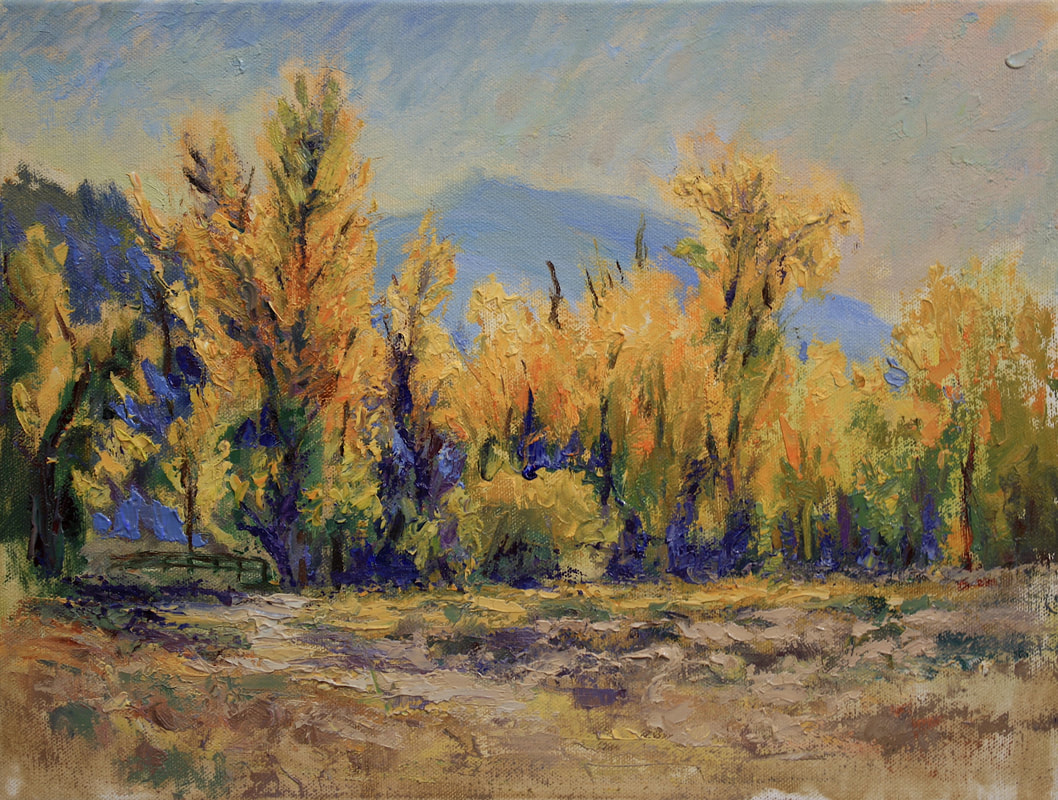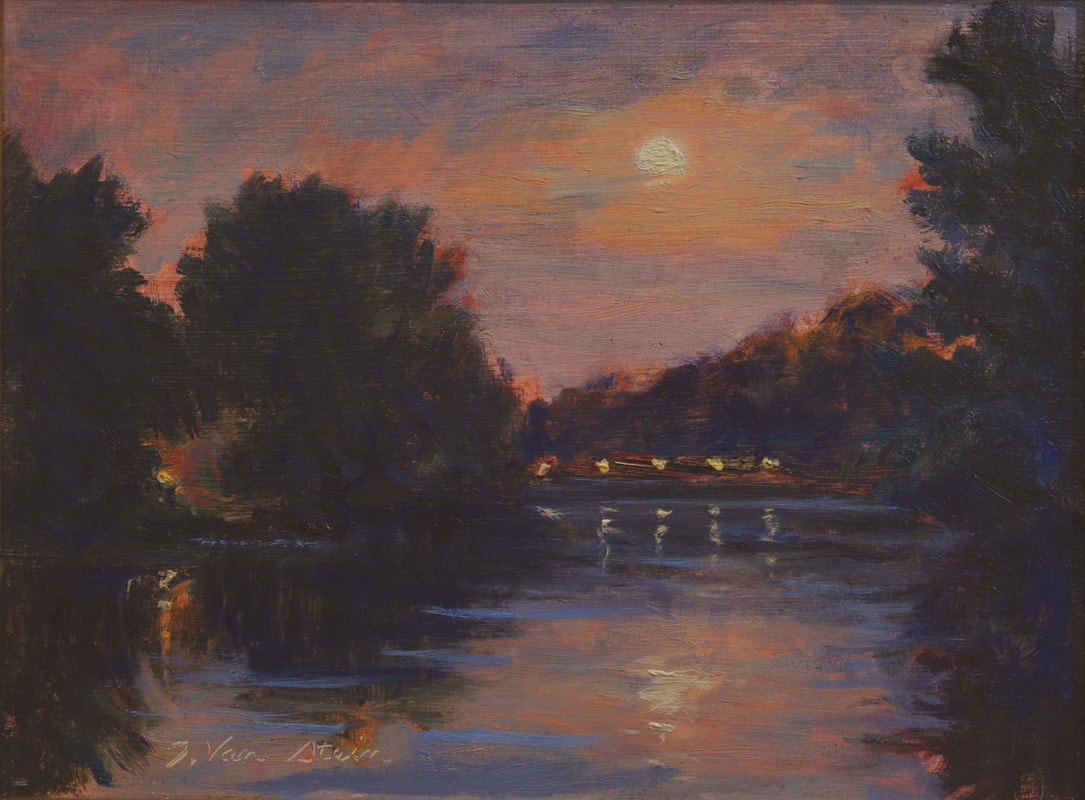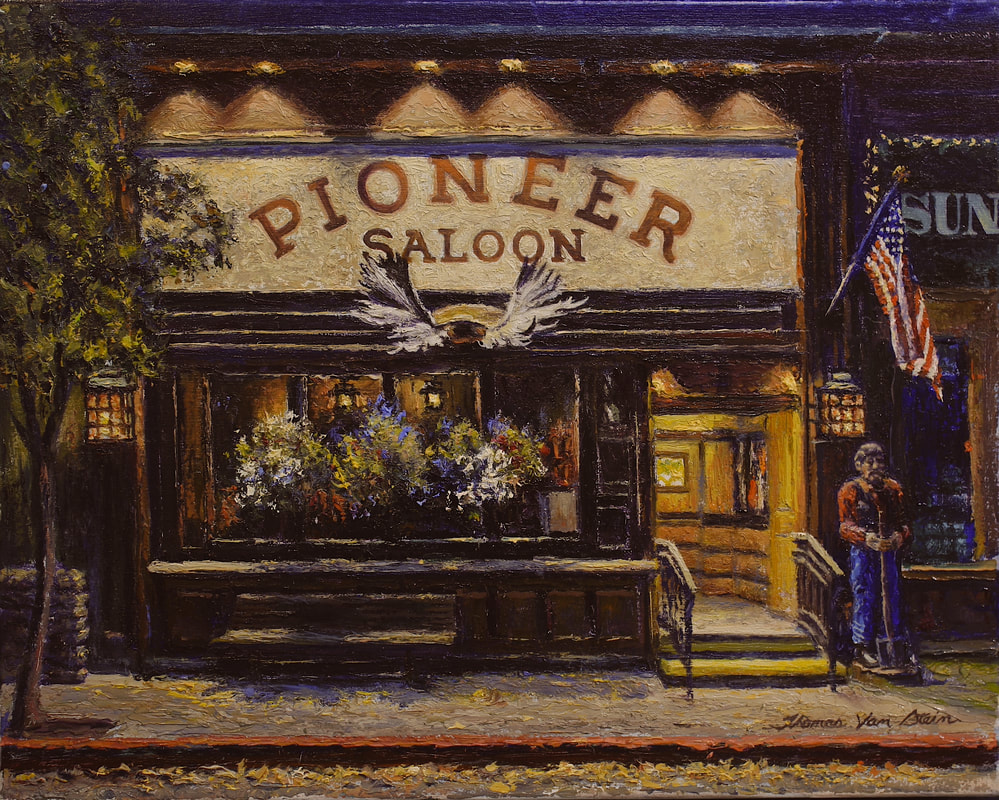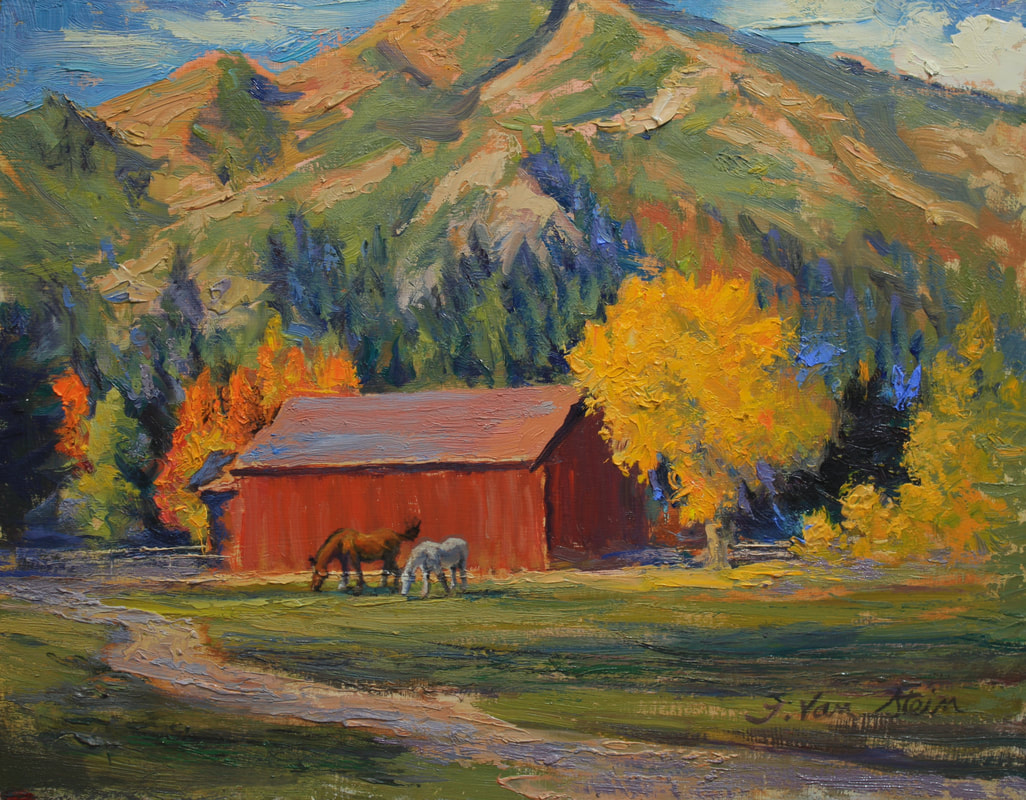Thomas Van Stein
Fine Artist
https://www.thomasvanstein.net
Phone
805 962-2776
E-mail: [email protected]
Moonlit Nocturnes
Wolf Moon Nocturne
12 x 9. Oil / Canvas
12 x 9. Oil / Canvas
Moonrise, Westlake
25.5 x 30.5 Oil/board
25.5 x 30.5 Oil/board
ABOUT THOMAS VAN STEIN
Growing up in Burbank, California Thomas attended California State University, Northridge, studying under artists like Houston Conwell, Norman Fullner, Tom Fricano, and Hans Burkhardt. His illustration skills were enhanced and directed by American Illustrator Barry Jackson.
Thomas also attended Art Center, where he met his mentor American impressionist painter, Dan McCaw, guiding Thomas in a deeper understanding and philosophy of the art spirit, based on design and color relationships mixed with a dry sense of humor.
After taking a year off to travel the world Thomas sketched and painted more diligently.
Eventually Thomas settled in Santa Barbara, California, a region already rich with the legacy of plein air landscape painters like Carl Oscar Borg, Colin Campbell Cooper, and Ray Strong. In 1988 Thomas connected with Artists Arturo Tello and Ray Strong, and
began painting the classic California Landscape on Santa Cruz Island. He was then honored to become a member of the OAK Group, a nationally recognized organization of plein air artists dedicated to preserving open space.
Growing up in Burbank, California Thomas attended California State University, Northridge, studying under artists like Houston Conwell, Norman Fullner, Tom Fricano, and Hans Burkhardt. His illustration skills were enhanced and directed by American Illustrator Barry Jackson.
Thomas also attended Art Center, where he met his mentor American impressionist painter, Dan McCaw, guiding Thomas in a deeper understanding and philosophy of the art spirit, based on design and color relationships mixed with a dry sense of humor.
After taking a year off to travel the world Thomas sketched and painted more diligently.
Eventually Thomas settled in Santa Barbara, California, a region already rich with the legacy of plein air landscape painters like Carl Oscar Borg, Colin Campbell Cooper, and Ray Strong. In 1988 Thomas connected with Artists Arturo Tello and Ray Strong, and
began painting the classic California Landscape on Santa Cruz Island. He was then honored to become a member of the OAK Group, a nationally recognized organization of plein air artists dedicated to preserving open space.
Moonrise and High Tide Butterfly Beach
14 x 11 Oil / Board
$1900.00
14 x 11 Oil / Board
$1900.00
Summer Moonrise, Loon Point
14 x 18 Oil / Board
14 x 18 Oil / Board
The New York Optimist Interview With Thomas Van Stein
Thomas Van Stein M.A. in Art
California State University, Northridge
TNYO: Can you tell us about your experience being a professor of the arts, the schools you worked in, your favorite students and the highs and lows of teaching?
Thomas Van Stein: I’ve taught beginning students and professionals from all walks of life, ages 18-102 years old through Santa Barbara City College Continuing Education, for 30 years. I’ve taught workshops in landscape painting with an emphasis on nocturnes through the Scottsdale Artists School, in Arizona. I’ve developed the philosophy that every student is my teacher; teaching me what I needed to learn or recall that which I already knew. I truly feel that when the student is ready the teacher arrives. My favorite students were those who showed up to class, and practiced what I was teaching. They showed enthusiasm about art, they were curious and asked questions. The highs of teaching were when the students made breakthroughs, and the low points were when students were disrespectful, and forced me to “graduate” them from the class early.
TNYO: Your mentors and teachers, what was your academic experience like?
Thomas Van Stein: I remember every teacher I ever had, and when I eventually became a teacher myself, I developed a newfound respect for them. The academic environment was rigorous at times. I enjoyed the University environment because it offered me a wide variety of subjects which I could explore. If I was going to be an Illustrator, I would take classes that would help me understand more about the earth and including the sciences. It would help me develop my imagination.
As an illustration major, I learned what pulling “all-nighters” was about. My Illustration teacher, Barry Jackson, would come into class after painting for 36 hours straight on a movie poster. He frequently looked bedraggled and disheveled. I thought, “If he could do it, I could do it!” I tried it a couple of times, and realized the stress of the job wasn’t worth it. Watson Cross, and Houston Conwell opened my eyes to anatomy.
I had Dan McCaw as a teacher at the Art Center. He also encouraged me to pursue fine art rather than commercial art. The greatest teachers were the greatest students, and the teachers I had influenced me, they still are in my mind and with me every brushstroke along the way.
TNYO: In your studio what does your process consist of?
Thomas Van Stein: I want to arrive at my studio with a critical eye. Then it is all about priorities; what am I trying to say? I feel creating a work of art is nothing more than process orientation on a two-dimensional surface. With a blank canvas before me: I ask myself, “What tone the canvas, get rid of the white. Line in the composition. Mass in the simplified design/shapes, (no more than 5 values). I paint darkest values to lighter values but in the mid value 4-5-6 range, thin to fat. Once the painting is massed in and harmonized in value, I then mix up more paint on my palette to start to develop the masses, being mindful of edges. In painting, everything is relative to what is next to it. So, I work outward from the mid value range, in the direction of darker darks in order to make the lights look lighter, or lighter lights to make the darks look darker, each note affects the whole, causing the other to appear different. I hold off on the highlights until the very end. When I’m satisfied with the progress that I have made I put my brushes down.
The next day when I see the painting in its unfinished state, I wonder who ruined it overnight? Regardless, my complete satisfaction with a painting is short lived, so I ask, “What’s wrong with this painting?” Then I begin by scraping away something in order to make something unpredictable happen. It’s not what goes into the painting that makes it work, but often what is edited out!
TNYO: What is your favorite color?
Thomas Van Stein: Any color that is in harmony with what other colors are surrounding it. Any note of color has four considerations: Specifically, what is the Color, its Value, its Temperature, and its Intensity (Chroma). Once the note is realized, then it comes down to the challenge of how to make it appear as a more beautiful color, but in relationship with the whole of the painting.
TNYO: The moon is powerful, and I believe in combination with the sun our lives on this planet are greatly influenced by these 2 cosmic forces amongst the power of the other planets in the universe. What is your perception of these concepts?
Thomas Van Stein: I am amazed by both Sun and Moon. I feel both entities transcend time. When I am outside painting en plein air, especially at night underneath the moonlight, I think back at how ancient the moon is, and the fact that the face of the moon is the exact image that was looked upon by all of humanity, for millions of years. I am seeing the same moon face that was witnessed by Imhotep III, Krishna, Buddha, Alexander the Great, Jesus, Clara Barton, and the Marx Brothers. (Just to name a few deities.) On his deathbed, Legendary J.M.W. Turner proclaimed, “The Sun is God!” I see his point.
TNYO: In your nocturnal Landscapes the moons you paint are caressed by the sky and the landscapes; they are absolutely magical. Do you believe in magic and if so, how does that magic influence your work?
Thomas Van Stein: I am attracted by light, in day or night, and how sunlight falls on the form. When I am painting nocturnes, whether urban or moonlight, I am searching for the dramatic contrast of light and dark, or “Chiaroscuro.” If I get the relationship right, I will achieve a certain timelessness of the subject, all due to capturing the light. Like Edward Hopper’s NightHawks, the lights in the diner will always appear to be on! So, I don’t necessarily believe in magic, however the very act of manifesting a work of art stems from bringing the illusion of spirit into form, creating something from nothing. If all elements are realized within a work of art successfully, its manifestation is a form of alchemy.
TNYO: How important is drafting and drawing to you?
Thomas Van Stein: Seeing/drawing is a fundamental foundation to my process. Drawing is a way to record empirically that which is before me and doing so I achieve a level of enlightenment through my observations. I am a visual person so I get it when an idea is figuratively “drawn” for me, but I also feel I can’t negate the auditory and/or physical characteristics of my subjects to help me express that which I am attempting to communicate.
TNYO: Have you been an artist since childhood?
Thomas Van Stein: I learned to draw/scribble when I was four. My parents saw how therapeutic and “healing” coloring was by allowing me to process my emotions. After a series of life-threatening accidents which opened my eyes to the world, I used drawing as an avenue to document my life’s journey and interest in researching historic subjects.
TNYO: What is your opinion on environments, upbringing, and relationships in regard to how it affects your art?
Thomas Van Stein: I think being an artist is a choice. If one chooses the artist’s path it is important to surround themselves with nature, art, and people who are also supportive of your path of choice. My relationships with family and friends affect me profoundly, giving me confidence both in the choices I’ve made, and continue to make. I paint with peace of mind.
TNYO: What would you do for a living now if you were not an artist?
Thomas Van Stein: I would be an archaeologist, or National Geographic Photographer. I am a curious being who loves asking questions and understanding things. I especially want to understand why things are the way they are and connect the dots on how they came to be. My camera is a tool to capture the unexpected scene/event before me and share it with the world. My goal for my art is to stop the viewer's eye and get them to be curious about what it is that intrigues them.
TNYO: Your resume and CV are absolutely incredible. We would be thrilled to know about how you have accumulated so many awards and exhibitions over the years.
Thomas Van Stein: Thank you for the acknowledgement! I'm 62 and began my professional art career at 25 so that's plenty of years to accumulate experience. I've kept a journal since I was 16 and I really feel because of that discipline, I seem to attract opportunities to enhance the adventure of pursuing art as a career/vocation. I look at the awards as just luck. I had a football coach who use to say that “Luck is where opportunity meets preparation!” So, I look at life from one breath to the next as an opportunity to create and improve on my art. The results of my efforts (awards, commissions, etc.) are icing on the cake. They serve as nudges from the universe letting me know I'm on track, living the life I am meant to live.
TNYO: Do you have any advice for students or anyone who is interested in becoming an artist?
Thomas Van Stein: Focus! Be present, notice the miracle of life surrounding you, draw and/or paint it! Find your passion. Surround yourself with art and art books. Live it, breathe it, eat it, BE it. To pursue an art career you need to become an obsession. One must realize that choosing an artist’s path is more a way of being. One can live creatively and be an artist in life; it doesn’t matter which medium one chooses, just enjoy the process of being an open vessel for the divine. Learn to draw; drawing will become painting. Get to work! Remember, an artist’s job is to produce. My artist/mentor, Ovanes Berberian motivated me by saying, “If you don’t paint every day, it puts you back three days. If you don’t paint for three days, it can set you back three weeks. If you don’t paint for three weeks, it can set you back for three years!” Study the Masters! Get to the configuration of your motif. Remember, it’s not about copying your subject, but expressing your own idea, your own personal interpretation and perception about it. Keep in mind that it’s not what the apple looks like, but remembering and expressing the sensation of what it tastes like!
Get miles of canvas behind you, find your idiom, mitier’.
TNYO: Where is your current studio located and are you happy in your current environment - are you stimulated and inspired?
Thomas Van Stein: I love plein-air painting, so I am not reliant on studio space for my inspiration or stimulation. I have two studios: My one studio is in an old 19th Century barn, in my home away from home; Santa Barbara. I’ve had the space for over thirty years and the environment is fantastic. My new temporary indoor studio is in a converted garage where I live currently in Garden City, Idaho. This space is o.k. for now. But I look forward to improving my studio location in the future. I had a wonderful artist/mentor, Dan McCaw, once told me, “You should be able to paint inside a phone booth if you have to!” So, I’ll accept the challenge while I am here in Idaho, but I look forward to Wintering and painting in my studio in Santa Barbara.
TNYO: Did you connect with the film business through your art journeys in California?
Thomas Van Stein: Not so much directly, but on the periphery. I have collectors who work in the industry, so some of my paintings (and commissions) have wound up in their collections. One of my murals was recently featured in a TV show called, “Drive-ins, Diners and Dives.” I was once interviewed by PBS’s Huell Howser for an episode of California’s Green, featuring the “OAK Group” which I am honored to be a 32 yearlong member.
TNYO: Is music important in your painting process? Do you listen to music when you're working?
Thomas Van Stein: All the time. It is rare that I am working in the studio without sound. I like a wide variety of music from BlueGrass and Ballads to Classical Symphonies and contemporary folk music. (It all comes from the same source). Quite often, I will listen to music that is related to whatever it is I am painting, like a Chopin nocturne for a Moonlight painting. When I am working en Plein-air, I will mostly listen to sounds of the surrounding environment, that way I can keep a situational awareness of my surroundings, especially at night! Again, it depends on my mood. I love so many different kinds of music and appreciate the musical talents. Ballads by Elton John, Mark Knopfler, Dylan, or classic rock by Fleetwood Mac, Beatles, etc. Or I sometimes love to listen to more classical music by Mozart, Beethoven, Bach or Boccherini, with a topper of Hank Williams, Wyllie Nelson, and Waylon Jennings. I once did an illustration of the screaming Indian head logo of the WWI American Mercenary Pilots of the Lafayette Escadrille, so I blasted the sounds of Native American War Chants to amplify the energy of what that symbol represented at that time.
TNYO: Can you pick a favorite song for your readers to listen to?
Thomas Van Stein: Beethoven’s 9th symphony is always a reliable anecdote for all my multi-dimensional moods.
Thomas Van Stein: Seeing/drawing is a fundamental foundation to my process. Drawing is a way to record empirically that which is before me and doing so I achieve a level of enlightenment through my observations. I am a visual person so I get it when an idea is figuratively “drawn” for me, but I also feel I can’t negate the auditory and/or physical characteristics of my subjects to help me express that which I am attempting to communicate.
TNYO: Have you been an artist since childhood?
Thomas Van Stein: I learned to draw/scribble when I was four. My parents saw how therapeutic and “healing” coloring was by allowing me to process my emotions. After a series of life-threatening accidents which opened my eyes to the world, I used drawing as an avenue to document my life’s journey and interest in researching historic subjects.
TNYO: What is your opinion on environments, upbringing, and relationships in regard to how it affects your art?
Thomas Van Stein: I think being an artist is a choice. If one chooses the artist’s path it is important to surround themselves with nature, art, and people who are also supportive of your path of choice. My relationships with family and friends affect me profoundly, giving me confidence both in the choices I’ve made, and continue to make. I paint with peace of mind.
TNYO: What would you do for a living now if you were not an artist?
Thomas Van Stein: I would be an archaeologist, or National Geographic Photographer. I am a curious being who loves asking questions and understanding things. I especially want to understand why things are the way they are and connect the dots on how they came to be. My camera is a tool to capture the unexpected scene/event before me and share it with the world. My goal for my art is to stop the viewer's eye and get them to be curious about what it is that intrigues them.
TNYO: Your resume and CV are absolutely incredible. We would be thrilled to know about how you have accumulated so many awards and exhibitions over the years.
Thomas Van Stein: Thank you for the acknowledgement! I'm 62 and began my professional art career at 25 so that's plenty of years to accumulate experience. I've kept a journal since I was 16 and I really feel because of that discipline, I seem to attract opportunities to enhance the adventure of pursuing art as a career/vocation. I look at the awards as just luck. I had a football coach who use to say that “Luck is where opportunity meets preparation!” So, I look at life from one breath to the next as an opportunity to create and improve on my art. The results of my efforts (awards, commissions, etc.) are icing on the cake. They serve as nudges from the universe letting me know I'm on track, living the life I am meant to live.
TNYO: Do you have any advice for students or anyone who is interested in becoming an artist?
Thomas Van Stein: Focus! Be present, notice the miracle of life surrounding you, draw and/or paint it! Find your passion. Surround yourself with art and art books. Live it, breathe it, eat it, BE it. To pursue an art career you need to become an obsession. One must realize that choosing an artist’s path is more a way of being. One can live creatively and be an artist in life; it doesn’t matter which medium one chooses, just enjoy the process of being an open vessel for the divine. Learn to draw; drawing will become painting. Get to work! Remember, an artist’s job is to produce. My artist/mentor, Ovanes Berberian motivated me by saying, “If you don’t paint every day, it puts you back three days. If you don’t paint for three days, it can set you back three weeks. If you don’t paint for three weeks, it can set you back for three years!” Study the Masters! Get to the configuration of your motif. Remember, it’s not about copying your subject, but expressing your own idea, your own personal interpretation and perception about it. Keep in mind that it’s not what the apple looks like, but remembering and expressing the sensation of what it tastes like!
Get miles of canvas behind you, find your idiom, mitier’.
TNYO: Where is your current studio located and are you happy in your current environment - are you stimulated and inspired?
Thomas Van Stein: I love plein-air painting, so I am not reliant on studio space for my inspiration or stimulation. I have two studios: My one studio is in an old 19th Century barn, in my home away from home; Santa Barbara. I’ve had the space for over thirty years and the environment is fantastic. My new temporary indoor studio is in a converted garage where I live currently in Garden City, Idaho. This space is o.k. for now. But I look forward to improving my studio location in the future. I had a wonderful artist/mentor, Dan McCaw, once told me, “You should be able to paint inside a phone booth if you have to!” So, I’ll accept the challenge while I am here in Idaho, but I look forward to Wintering and painting in my studio in Santa Barbara.
TNYO: Did you connect with the film business through your art journeys in California?
Thomas Van Stein: Not so much directly, but on the periphery. I have collectors who work in the industry, so some of my paintings (and commissions) have wound up in their collections. One of my murals was recently featured in a TV show called, “Drive-ins, Diners and Dives.” I was once interviewed by PBS’s Huell Howser for an episode of California’s Green, featuring the “OAK Group” which I am honored to be a 32 yearlong member.
TNYO: Is music important in your painting process? Do you listen to music when you're working?
Thomas Van Stein: All the time. It is rare that I am working in the studio without sound. I like a wide variety of music from BlueGrass and Ballads to Classical Symphonies and contemporary folk music. (It all comes from the same source). Quite often, I will listen to music that is related to whatever it is I am painting, like a Chopin nocturne for a Moonlight painting. When I am working en Plein-air, I will mostly listen to sounds of the surrounding environment, that way I can keep a situational awareness of my surroundings, especially at night! Again, it depends on my mood. I love so many different kinds of music and appreciate the musical talents. Ballads by Elton John, Mark Knopfler, Dylan, or classic rock by Fleetwood Mac, Beatles, etc. Or I sometimes love to listen to more classical music by Mozart, Beethoven, Bach or Boccherini, with a topper of Hank Williams, Wyllie Nelson, and Waylon Jennings. I once did an illustration of the screaming Indian head logo of the WWI American Mercenary Pilots of the Lafayette Escadrille, so I blasted the sounds of Native American War Chants to amplify the energy of what that symbol represented at that time.
TNYO: Can you pick a favorite song for your readers to listen to?
Thomas Van Stein: Beethoven’s 9th symphony is always a reliable anecdote for all my multi-dimensional moods.
Thomas Van Stein M.A. in Art
California State University, Northridge
TNYO: Can you tell us about your experience being a professor of the arts, the schools you worked in, your favorite students and the highs and lows of teaching?
Thomas Van Stein: I’ve taught beginning students and professionals from all walks of life, ages 18-102 years old through Santa Barbara City College Continuing Education, for 30 years. I’ve taught workshops in landscape painting with an emphasis on nocturnes through the Scottsdale Artists School, in Arizona. I’ve developed the philosophy that every student is my teacher; teaching me what I needed to learn or recall that which I already knew. I truly feel that when the student is ready the teacher arrives. My favorite students were those who showed up to class, and practiced what I was teaching. They showed enthusiasm about art, they were curious and asked questions. The highs of teaching were when the students made breakthroughs, and the low points were when students were disrespectful, and forced me to “graduate” them from the class early.
TNYO: Your mentors and teachers, what was your academic experience like?
Thomas Van Stein: I remember every teacher I ever had, and when I eventually became a teacher myself, I developed a newfound respect for them. The academic environment was rigorous at times. I enjoyed the University environment because it offered me a wide variety of subjects which I could explore. If I was going to be an Illustrator, I would take classes that would help me understand more about the earth and including the sciences. It would help me develop my imagination.
As an illustration major, I learned what pulling “all-nighters” was about. My Illustration teacher, Barry Jackson, would come into class after painting for 36 hours straight on a movie poster. He frequently looked bedraggled and disheveled. I thought, “If he could do it, I could do it!” I tried it a couple of times, and realized the stress of the job wasn’t worth it. Watson Cross, and Houston Conwell opened my eyes to anatomy.
I had Dan McCaw as a teacher at the Art Center. He also encouraged me to pursue fine art rather than commercial art. The greatest teachers were the greatest students, and the teachers I had influenced me, they still are in my mind and with me every brushstroke along the way.
TNYO: In your studio what does your process consist of?
Thomas Van Stein: I want to arrive at my studio with a critical eye. Then it is all about priorities; what am I trying to say? I feel creating a work of art is nothing more than process orientation on a two-dimensional surface. With a blank canvas before me: I ask myself, “What tone the canvas, get rid of the white. Line in the composition. Mass in the simplified design/shapes, (no more than 5 values). I paint darkest values to lighter values but in the mid value 4-5-6 range, thin to fat. Once the painting is massed in and harmonized in value, I then mix up more paint on my palette to start to develop the masses, being mindful of edges. In painting, everything is relative to what is next to it. So, I work outward from the mid value range, in the direction of darker darks in order to make the lights look lighter, or lighter lights to make the darks look darker, each note affects the whole, causing the other to appear different. I hold off on the highlights until the very end. When I’m satisfied with the progress that I have made I put my brushes down.
The next day when I see the painting in its unfinished state, I wonder who ruined it overnight? Regardless, my complete satisfaction with a painting is short lived, so I ask, “What’s wrong with this painting?” Then I begin by scraping away something in order to make something unpredictable happen. It’s not what goes into the painting that makes it work, but often what is edited out!
TNYO: What is your favorite color?
Thomas Van Stein: Any color that is in harmony with what other colors are surrounding it. Any note of color has four considerations: Specifically, what is the Color, its Value, its Temperature, and its Intensity (Chroma). Once the note is realized, then it comes down to the challenge of how to make it appear as a more beautiful color, but in relationship with the whole of the painting.
TNYO: The moon is powerful, and I believe in combination with the sun our lives on this planet are greatly influenced by these 2 cosmic forces amongst the power of the other planets in the universe. What is your perception of these concepts?
Thomas Van Stein: I am amazed by both Sun and Moon. I feel both entities transcend time. When I am outside painting en plein air, especially at night underneath the moonlight, I think back at how ancient the moon is, and the fact that the face of the moon is the exact image that was looked upon by all of humanity, for millions of years. I am seeing the same moon face that was witnessed by Imhotep III, Krishna, Buddha, Alexander the Great, Jesus, Clara Barton, and the Marx Brothers. (Just to name a few deities.) On his deathbed, Legendary J.M.W. Turner proclaimed, “The Sun is God!” I see his point.
TNYO: In your nocturnal Landscapes the moons you paint are caressed by the sky and the landscapes; they are absolutely magical. Do you believe in magic and if so, how does that magic influence your work?
Thomas Van Stein: I am attracted by light, in day or night, and how sunlight falls on the form. When I am painting nocturnes, whether urban or moonlight, I am searching for the dramatic contrast of light and dark, or “Chiaroscuro.” If I get the relationship right, I will achieve a certain timelessness of the subject, all due to capturing the light. Like Edward Hopper’s NightHawks, the lights in the diner will always appear to be on! So, I don’t necessarily believe in magic, however the very act of manifesting a work of art stems from bringing the illusion of spirit into form, creating something from nothing. If all elements are realized within a work of art successfully, its manifestation is a form of alchemy.
TNYO: How important is drafting and drawing to you?
Thomas Van Stein: Seeing/drawing is a fundamental foundation to my process. Drawing is a way to record empirically that which is before me and doing so I achieve a level of enlightenment through my observations. I am a visual person so I get it when an idea is figuratively “drawn” for me, but I also feel I can’t negate the auditory and/or physical characteristics of my subjects to help me express that which I am attempting to communicate.
TNYO: Have you been an artist since childhood?
Thomas Van Stein: I learned to draw/scribble when I was four. My parents saw how therapeutic and “healing” coloring was by allowing me to process my emotions. After a series of life-threatening accidents which opened my eyes to the world, I used drawing as an avenue to document my life’s journey and interest in researching historic subjects.
TNYO: What is your opinion on environments, upbringing, and relationships in regard to how it affects your art?
Thomas Van Stein: I think being an artist is a choice. If one chooses the artist’s path it is important to surround themselves with nature, art, and people who are also supportive of your path of choice. My relationships with family and friends affect me profoundly, giving me confidence both in the choices I’ve made, and continue to make. I paint with peace of mind.
TNYO: What would you do for a living now if you were not an artist?
Thomas Van Stein: I would be an archaeologist, or National Geographic Photographer. I am a curious being who loves asking questions and understanding things. I especially want to understand why things are the way they are and connect the dots on how they came to be. My camera is a tool to capture the unexpected scene/event before me and share it with the world. My goal for my art is to stop the viewer's eye and get them to be curious about what it is that intrigues them.
TNYO: Your resume and CV are absolutely incredible. We would be thrilled to know about how you have accumulated so many awards and exhibitions over the years.
Thomas Van Stein: Thank you for the acknowledgement! I'm 62 and began my professional art career at 25 so that's plenty of years to accumulate experience. I've kept a journal since I was 16 and I really feel because of that discipline, I seem to attract opportunities to enhance the adventure of pursuing art as a career/vocation. I look at the awards as just luck. I had a football coach who use to say that “Luck is where opportunity meets preparation!” So, I look at life from one breath to the next as an opportunity to create and improve on my art. The results of my efforts (awards, commissions, etc.) are icing on the cake. They serve as nudges from the universe letting me know I'm on track, living the life I am meant to live.
TNYO: Do you have any advice for students or anyone who is interested in becoming an artist?
Thomas Van Stein: Focus! Be present, notice the miracle of life surrounding you, draw and/or paint it! Find your passion. Surround yourself with art and art books. Live it, breathe it, eat it, BE it. To pursue an art career you need to become an obsession. One must realize that choosing an artist’s path is more a way of being. One can live creatively and be an artist in life; it doesn’t matter which medium one chooses, just enjoy the process of being an open vessel for the divine. Learn to draw; drawing will become painting. Get to work! Remember, an artist’s job is to produce. My artist/mentor, Ovanes Berberian motivated me by saying, “If you don’t paint every day, it puts you back three days. If you don’t paint for three days, it can set you back three weeks. If you don’t paint for three weeks, it can set you back for three years!” Study the Masters! Get to the configuration of your motif. Remember, it’s not about copying your subject, but expressing your own idea, your own personal interpretation and perception about it. Keep in mind that it’s not what the apple looks like, but remembering and expressing the sensation of what it tastes like!
Get miles of canvas behind you, find your idiom, mitier’.
TNYO: Where is your current studio located and are you happy in your current environment - are you stimulated and inspired?
Thomas Van Stein: I love plein-air painting, so I am not reliant on studio space for my inspiration or stimulation. I have two studios: My one studio is in an old 19th Century barn, in my home away from home; Santa Barbara. I’ve had the space for over thirty years and the environment is fantastic. My new temporary indoor studio is in a converted garage where I live currently in Garden City, Idaho. This space is o.k. for now. But I look forward to improving my studio location in the future. I had a wonderful artist/mentor, Dan McCaw, once told me, “You should be able to paint inside a phone booth if you have to!” So, I’ll accept the challenge while I am here in Idaho, but I look forward to Wintering and painting in my studio in Santa Barbara.
TNYO: Did you connect with the film business through your art journeys in California?
Thomas Van Stein: Not so much directly, but on the periphery. I have collectors who work in the industry, so some of my paintings (and commissions) have wound up in their collections. One of my murals was recently featured in a TV show called, “Drive-ins, Diners and Dives.” I was once interviewed by PBS’s Huell Howser for an episode of California’s Green, featuring the “OAK Group” which I am honored to be a 32 yearlong member.
TNYO: Is music important in your painting process? Do you listen to music when you're working?
Thomas Van Stein: All the time. It is rare that I am working in the studio without sound. I like a wide variety of music from BlueGrass and Ballads to Classical Symphonies and contemporary folk music. (It all comes from the same source). Quite often, I will listen to music that is related to whatever it is I am painting, like a Chopin nocturne for a Moonlight painting. When I am working en Plein-air, I will mostly listen to sounds of the surrounding environment, that way I can keep a situational awareness of my surroundings, especially at night! Again, it depends on my mood. I love so many different kinds of music and appreciate the musical talents. Ballads by Elton John, Mark Knopfler, Dylan, or classic rock by Fleetwood Mac, Beatles, etc. Or I sometimes love to listen to more classical music by Mozart, Beethoven, Bach or Boccherini, with a topper of Hank Williams, Wyllie Nelson, and Waylon Jennings. I once did an illustration of the screaming Indian head logo of the WWI American Mercenary Pilots of the Lafayette Escadrille, so I blasted the sounds of Native American War Chants to amplify the energy of what that symbol represented at that time.
TNYO: Can you pick a favorite song for your readers to listen to?
Thomas Van Stein: Beethoven’s 9th symphony is always a reliable anecdote for all my multi-dimensional moods.
Thomas Van Stein: Seeing/drawing is a fundamental foundation to my process. Drawing is a way to record empirically that which is before me and doing so I achieve a level of enlightenment through my observations. I am a visual person so I get it when an idea is figuratively “drawn” for me, but I also feel I can’t negate the auditory and/or physical characteristics of my subjects to help me express that which I am attempting to communicate.
TNYO: Have you been an artist since childhood?
Thomas Van Stein: I learned to draw/scribble when I was four. My parents saw how therapeutic and “healing” coloring was by allowing me to process my emotions. After a series of life-threatening accidents which opened my eyes to the world, I used drawing as an avenue to document my life’s journey and interest in researching historic subjects.
TNYO: What is your opinion on environments, upbringing, and relationships in regard to how it affects your art?
Thomas Van Stein: I think being an artist is a choice. If one chooses the artist’s path it is important to surround themselves with nature, art, and people who are also supportive of your path of choice. My relationships with family and friends affect me profoundly, giving me confidence both in the choices I’ve made, and continue to make. I paint with peace of mind.
TNYO: What would you do for a living now if you were not an artist?
Thomas Van Stein: I would be an archaeologist, or National Geographic Photographer. I am a curious being who loves asking questions and understanding things. I especially want to understand why things are the way they are and connect the dots on how they came to be. My camera is a tool to capture the unexpected scene/event before me and share it with the world. My goal for my art is to stop the viewer's eye and get them to be curious about what it is that intrigues them.
TNYO: Your resume and CV are absolutely incredible. We would be thrilled to know about how you have accumulated so many awards and exhibitions over the years.
Thomas Van Stein: Thank you for the acknowledgement! I'm 62 and began my professional art career at 25 so that's plenty of years to accumulate experience. I've kept a journal since I was 16 and I really feel because of that discipline, I seem to attract opportunities to enhance the adventure of pursuing art as a career/vocation. I look at the awards as just luck. I had a football coach who use to say that “Luck is where opportunity meets preparation!” So, I look at life from one breath to the next as an opportunity to create and improve on my art. The results of my efforts (awards, commissions, etc.) are icing on the cake. They serve as nudges from the universe letting me know I'm on track, living the life I am meant to live.
TNYO: Do you have any advice for students or anyone who is interested in becoming an artist?
Thomas Van Stein: Focus! Be present, notice the miracle of life surrounding you, draw and/or paint it! Find your passion. Surround yourself with art and art books. Live it, breathe it, eat it, BE it. To pursue an art career you need to become an obsession. One must realize that choosing an artist’s path is more a way of being. One can live creatively and be an artist in life; it doesn’t matter which medium one chooses, just enjoy the process of being an open vessel for the divine. Learn to draw; drawing will become painting. Get to work! Remember, an artist’s job is to produce. My artist/mentor, Ovanes Berberian motivated me by saying, “If you don’t paint every day, it puts you back three days. If you don’t paint for three days, it can set you back three weeks. If you don’t paint for three weeks, it can set you back for three years!” Study the Masters! Get to the configuration of your motif. Remember, it’s not about copying your subject, but expressing your own idea, your own personal interpretation and perception about it. Keep in mind that it’s not what the apple looks like, but remembering and expressing the sensation of what it tastes like!
Get miles of canvas behind you, find your idiom, mitier’.
TNYO: Where is your current studio located and are you happy in your current environment - are you stimulated and inspired?
Thomas Van Stein: I love plein-air painting, so I am not reliant on studio space for my inspiration or stimulation. I have two studios: My one studio is in an old 19th Century barn, in my home away from home; Santa Barbara. I’ve had the space for over thirty years and the environment is fantastic. My new temporary indoor studio is in a converted garage where I live currently in Garden City, Idaho. This space is o.k. for now. But I look forward to improving my studio location in the future. I had a wonderful artist/mentor, Dan McCaw, once told me, “You should be able to paint inside a phone booth if you have to!” So, I’ll accept the challenge while I am here in Idaho, but I look forward to Wintering and painting in my studio in Santa Barbara.
TNYO: Did you connect with the film business through your art journeys in California?
Thomas Van Stein: Not so much directly, but on the periphery. I have collectors who work in the industry, so some of my paintings (and commissions) have wound up in their collections. One of my murals was recently featured in a TV show called, “Drive-ins, Diners and Dives.” I was once interviewed by PBS’s Huell Howser for an episode of California’s Green, featuring the “OAK Group” which I am honored to be a 32 yearlong member.
TNYO: Is music important in your painting process? Do you listen to music when you're working?
Thomas Van Stein: All the time. It is rare that I am working in the studio without sound. I like a wide variety of music from BlueGrass and Ballads to Classical Symphonies and contemporary folk music. (It all comes from the same source). Quite often, I will listen to music that is related to whatever it is I am painting, like a Chopin nocturne for a Moonlight painting. When I am working en Plein-air, I will mostly listen to sounds of the surrounding environment, that way I can keep a situational awareness of my surroundings, especially at night! Again, it depends on my mood. I love so many different kinds of music and appreciate the musical talents. Ballads by Elton John, Mark Knopfler, Dylan, or classic rock by Fleetwood Mac, Beatles, etc. Or I sometimes love to listen to more classical music by Mozart, Beethoven, Bach or Boccherini, with a topper of Hank Williams, Wyllie Nelson, and Waylon Jennings. I once did an illustration of the screaming Indian head logo of the WWI American Mercenary Pilots of the Lafayette Escadrille, so I blasted the sounds of Native American War Chants to amplify the energy of what that symbol represented at that time.
TNYO: Can you pick a favorite song for your readers to listen to?
Thomas Van Stein: Beethoven’s 9th symphony is always a reliable anecdote for all my multi-dimensional moods.
Winter Moonset, Butterfly Beach
10 x 14 Oil / Canvas
10 x 14 Oil / Canvas
August Moonset, Butterfly
24.5 x 36.5 Oil / Board
24.5 x 36.5 Oil / Board
In 1992, Thomas began teaching art through Santa Barbara City College Continuing Education. He also began entering art festivals and won first prize at the Catalina Island Art Festival, juried by Christopher Lance, in both Most Original Art and Best of Show. Arturo Tello introduced to him the genre of painting night scenes on location.
After three solo exhibitions with Nocturnes as a theme, Thomas returned to Cal State University Northridge to achieve his Master’s Degree Studying under American artist Bruce Everett, Thomas spent two years wandering the dark eerie nights in urban settings. “I was to paint unsellable art for two years setting up in locations nobody likes to go at night.” In 1999, for his diligence and tenacity, Thomas received the Hans Burkhardt Award in painting, and graduated cum laude with a Master’s Degree in Art. During this time, he entered into and won his first National Juried Exhibition held at the Abend Gallery in Denver Colorado, juried by nationally acclaimed artist Quang Ho.
Thomas wrote an article on night painting, and was published as the cover artist for the September 1996 issue of The Artist’s Magazine. During his quest for a master’s degree, Thomas received private commissions that sent him to paint in Lake Como, Italy, and Segovia, Spain.
He also met his new mentor, Ovanes Berberian, and soon began studying the depth and value of the Russian palette in his workshops in
Carpinteria and Idaho. Both Ovanes and Dan McCaw studied under Sergei Bongart, so their legacy continued to inspire through Thomas' art.
In the early 2000’s, Thomas achieved gallery representation and a solo exhibition of his Moonlight Nocturnes at the Eleanor Ettinger Gallery in New York City. He also won the Individual Artist Award for Santa Barbara County, and both First Prize and Director’s Choice in the Carnegie Art Museum in Oxnard California’s Classic Art Competition. In 2005, he had his first Solo Museum Exhibition at the Carnegie Art Museum in Oxnard
featuring thirty new Urban Nocturne paintings.
After three solo exhibitions with Nocturnes as a theme, Thomas returned to Cal State University Northridge to achieve his Master’s Degree Studying under American artist Bruce Everett, Thomas spent two years wandering the dark eerie nights in urban settings. “I was to paint unsellable art for two years setting up in locations nobody likes to go at night.” In 1999, for his diligence and tenacity, Thomas received the Hans Burkhardt Award in painting, and graduated cum laude with a Master’s Degree in Art. During this time, he entered into and won his first National Juried Exhibition held at the Abend Gallery in Denver Colorado, juried by nationally acclaimed artist Quang Ho.
Thomas wrote an article on night painting, and was published as the cover artist for the September 1996 issue of The Artist’s Magazine. During his quest for a master’s degree, Thomas received private commissions that sent him to paint in Lake Como, Italy, and Segovia, Spain.
He also met his new mentor, Ovanes Berberian, and soon began studying the depth and value of the Russian palette in his workshops in
Carpinteria and Idaho. Both Ovanes and Dan McCaw studied under Sergei Bongart, so their legacy continued to inspire through Thomas' art.
In the early 2000’s, Thomas achieved gallery representation and a solo exhibition of his Moonlight Nocturnes at the Eleanor Ettinger Gallery in New York City. He also won the Individual Artist Award for Santa Barbara County, and both First Prize and Director’s Choice in the Carnegie Art Museum in Oxnard California’s Classic Art Competition. In 2005, he had his first Solo Museum Exhibition at the Carnegie Art Museum in Oxnard
featuring thirty new Urban Nocturne paintings.
Moonrise sketch
9 x 12 Oil / Board
9 x 12 Oil / Board
Thomas regularly teaches night painting workshops in Santa Barbara. In 2006 one of his workshops became a fourteen page feature article in the Fall issue of the American Artist Workshops Magazine about his processes and techniques for Nocturnal Painting.
While continuing to teach art classes and workshops in various locations, in California and Mexico, Thomas exhibits his paintings
annually in both solo and group exhibitions.
Through his national and international connections, he has received numerous commissions to travel and produce paintings
here in the United States and Europe. In 2021-2022 his training in illustration and ability to render his drawings in pen and ink
has landed him the opportunity to create an entire brand of wine labels called Crosshatch Wines. In 2023, Edible Magazine
awarded him with Wine Label illustration of the Year.
Thomas continues to enter into and receive awards in plein air festivals in California and Idaho. Thomas and his wife Cyndi spend time in both Santa Barbara, CA and in the Northern Rockies, painting the dramatic light-filled landscapes around Sun Valley, Idaho, Yellowstone Jackson Hole, Wyoming. In the Fall of 2023, as an adjunct professor, Thomas will be teaching Art at Boise State University.
While continuing to teach art classes and workshops in various locations, in California and Mexico, Thomas exhibits his paintings
annually in both solo and group exhibitions.
Through his national and international connections, he has received numerous commissions to travel and produce paintings
here in the United States and Europe. In 2021-2022 his training in illustration and ability to render his drawings in pen and ink
has landed him the opportunity to create an entire brand of wine labels called Crosshatch Wines. In 2023, Edible Magazine
awarded him with Wine Label illustration of the Year.
Thomas continues to enter into and receive awards in plein air festivals in California and Idaho. Thomas and his wife Cyndi spend time in both Santa Barbara, CA and in the Northern Rockies, painting the dramatic light-filled landscapes around Sun Valley, Idaho, Yellowstone Jackson Hole, Wyoming. In the Fall of 2023, as an adjunct professor, Thomas will be teaching Art at Boise State University.
Moonlit Waves
30 x 48 Oil / Canvas
30 x 48 Oil / Canvas
Moonrise and Fog, Butterfly Beach
18 x 24 Oil / Canvas
$3250.00
18 x 24 Oil / Canvas
$3250.00
EDUCATION
1984 Bachelors Degree in Art, California State Univ., Northridge. Graduated Cum
Laude
1985 Pasadena Art Center, College of Design. Dan McCaw Mentorship.
1997-99 Masters Degree in Art, Cal State University, Northridge
1995-2000 Ovanes Berberian Mentorship
EXHIBITIONS + AWARDS
2022 Honorable Mention: Eagle Plein-air Art Festival Quick Draw Event
2022 Wine Label Illustration of the Year Crosshatch Wines Edible Magazine
2021 Waterhouse Gallery, Two-person Exhibition
2020 Juror: La Cumbre Center for Creative Arts
2018 Juror: Westlake Artist Guild
2017 Juror: Goleta Valley Art Association, Santa Barbara Art Association
2015 Juror: Ojai Valley Pastel Society
2014 103rd Annual California Art Club Gold Medal Exhibition, Los Angeles
2014 TRAC 2014 Ventura California
2013 The Armory Show, New York
2012 Winner: The People's Choice Award, Paso Robles Art Festival Quick Draw Event
2012-14 Oliver & Espvig, Santa Barbara
2011-12 James Main Fine Art Santa Barbara
2011 Urban II California Art Club Old Mill Gallery; Pasadena
2010 Solo Exhibition: Santa Barbara Architecture, Architectural Foundation of Santa
Barbara
2008 98th Annual Gold Medal Exhibition, Pasadena Historical Museum, California Art
Club
2006 96th Annual Gold Medal Exhibition, Pasadena Historical Museum, California Art
Club
2006 Waterhouse Gallery, Santa Barbara
2005 Elder Art Gallery Charlotte North Carolina
2005 Solo Museum Exhibition, "Urban Nocturnes; Carnegie Art Museum, Oxnard
California
2005 Juror, Santa Barbara Art Association, Carpinteria
2004 Individual Artist Award Exhibition, Santa Barbara County, Arts Fund Gallery
2000 Featured O.A.K, GROUP Artist, S,B, Artwalk, S.B. Museum of Natural History
2000 First Annual Organic Festival Art Show, Lacuna Gallery, Santa Barbara
2000 Bottoms Sea Arts Gallery, Biltmore, Montecito/Santa Barbara, California
2000 Spring Salon, Edenhurst Gallery, Los Angeles
2000 90th Annual Gold Medal Exhibition, Pasadena Historical Museum, California Art
Club
2000 Historic Buildings of the San Gabriel Valley, California Art Club Gallery, Pasadena
CA
2000 Moonlight Nocturnes; Solo Exhibition. Montecito Art Gallery, Montecito CA
2000 Juror, Santa Barbara Art Association
1999 Museum Director's Award, Santa Barbara Art Walk
1999 Burning the Midnight Oil; Master's Exhibition, Montecito Art Gallery
1999 89th Annual Gold Medal Exhibition, California Art Club, Los Angeles CA
1998 California Collectors Gallery, Kentfield, CA
1998 Cover Artist, Discovery Magazine, Santa Barbara, CA
1998 Small Images Show, Abend Gallery, Denver Colorado
1998 Laurence J. Cantor Fine Arts, Westlake, California
1998 Muse of the Channel, benefit for C.I.N.P.S. Museum of Natural History
1998 Santa Barbara Art Walk: Featured Artist, O.A.K. Group Exhibition
1998 Award, SBAA Junied Landscape exhibition, May
1998 "Art at Lotusland", Group Art Show. Montecito, California
1997 "American Tonalist Paintings: Reflections of Reverie, California Heritage Gallery,
San Francisco
1997 88th Annual Gold Medal Exhibition, California Art Club
1997-98 Award: Santa Barbara Art Association Juried Landscape Show
California Art Club Plein Air Competition, San Juan Capistrano
SELECTED EXHIBITIONS
Elder Art Gallery, Charlotte NC
Waterhouse Gallery Santa Barbara CA
Eleanor Ettinger Gallery
Santa Barbara Art Walk
Carnegie Museum of Art, Oxnard, CA
Bottoms Fine Art, Santa Barbara, CA
Pasadena Historical Museum
Lacuna Gallery, Santa Barbara, CA
Sea Arts Gallery, Biltmore, Montecito/Santa
Barbara, CA
Edenhurst Gallery, Los Angeles, CA
California Art Club Gallery, Pasadena, CA
Montecito Art Gallery, Montecito, CA
California Art Club, Los Angeles, CA
California Collectors Gallery, Kentfield, CA
Abend Gallery, Denver, CO
Laurence J. Cantor Fine Arts, Westlake, CA
Santa Barbara Museum of Natural History
Santa Barbara Art Association
California Heritage Gallery
Morseburg Gallery, Los Angeles, CA
Easton Gallery, Santa Barbara, CA
Gallery Off Grand, Los Olivos, CA
Alley Gallery, Carpinteria, CA
Arlington Gallery, Santa Barbara, CA
Faulkner Gallery, Santa Barbara, CA
Columbia Club Foundation, Indiana
Santa Barbara Botanical Gardens
Desert Oasis Show, Capitol Building,
Washington, D.C., Palm Springs,
Oakland Museum of Art
Arpel Gallery, Santa Barbara, CA
Outsiders Gallery, Santa Barbara, CA
1984 Bachelors Degree in Art, California State Univ., Northridge. Graduated Cum
Laude
1985 Pasadena Art Center, College of Design. Dan McCaw Mentorship.
1997-99 Masters Degree in Art, Cal State University, Northridge
1995-2000 Ovanes Berberian Mentorship
EXHIBITIONS + AWARDS
2022 Honorable Mention: Eagle Plein-air Art Festival Quick Draw Event
2022 Wine Label Illustration of the Year Crosshatch Wines Edible Magazine
2021 Waterhouse Gallery, Two-person Exhibition
2020 Juror: La Cumbre Center for Creative Arts
2018 Juror: Westlake Artist Guild
2017 Juror: Goleta Valley Art Association, Santa Barbara Art Association
2015 Juror: Ojai Valley Pastel Society
2014 103rd Annual California Art Club Gold Medal Exhibition, Los Angeles
2014 TRAC 2014 Ventura California
2013 The Armory Show, New York
2012 Winner: The People's Choice Award, Paso Robles Art Festival Quick Draw Event
2012-14 Oliver & Espvig, Santa Barbara
2011-12 James Main Fine Art Santa Barbara
2011 Urban II California Art Club Old Mill Gallery; Pasadena
2010 Solo Exhibition: Santa Barbara Architecture, Architectural Foundation of Santa
Barbara
2008 98th Annual Gold Medal Exhibition, Pasadena Historical Museum, California Art
Club
2006 96th Annual Gold Medal Exhibition, Pasadena Historical Museum, California Art
Club
2006 Waterhouse Gallery, Santa Barbara
2005 Elder Art Gallery Charlotte North Carolina
2005 Solo Museum Exhibition, "Urban Nocturnes; Carnegie Art Museum, Oxnard
California
2005 Juror, Santa Barbara Art Association, Carpinteria
2004 Individual Artist Award Exhibition, Santa Barbara County, Arts Fund Gallery
2000 Featured O.A.K, GROUP Artist, S,B, Artwalk, S.B. Museum of Natural History
2000 First Annual Organic Festival Art Show, Lacuna Gallery, Santa Barbara
2000 Bottoms Sea Arts Gallery, Biltmore, Montecito/Santa Barbara, California
2000 Spring Salon, Edenhurst Gallery, Los Angeles
2000 90th Annual Gold Medal Exhibition, Pasadena Historical Museum, California Art
Club
2000 Historic Buildings of the San Gabriel Valley, California Art Club Gallery, Pasadena
CA
2000 Moonlight Nocturnes; Solo Exhibition. Montecito Art Gallery, Montecito CA
2000 Juror, Santa Barbara Art Association
1999 Museum Director's Award, Santa Barbara Art Walk
1999 Burning the Midnight Oil; Master's Exhibition, Montecito Art Gallery
1999 89th Annual Gold Medal Exhibition, California Art Club, Los Angeles CA
1998 California Collectors Gallery, Kentfield, CA
1998 Cover Artist, Discovery Magazine, Santa Barbara, CA
1998 Small Images Show, Abend Gallery, Denver Colorado
1998 Laurence J. Cantor Fine Arts, Westlake, California
1998 Muse of the Channel, benefit for C.I.N.P.S. Museum of Natural History
1998 Santa Barbara Art Walk: Featured Artist, O.A.K. Group Exhibition
1998 Award, SBAA Junied Landscape exhibition, May
1998 "Art at Lotusland", Group Art Show. Montecito, California
1997 "American Tonalist Paintings: Reflections of Reverie, California Heritage Gallery,
San Francisco
1997 88th Annual Gold Medal Exhibition, California Art Club
1997-98 Award: Santa Barbara Art Association Juried Landscape Show
California Art Club Plein Air Competition, San Juan Capistrano
SELECTED EXHIBITIONS
Elder Art Gallery, Charlotte NC
Waterhouse Gallery Santa Barbara CA
Eleanor Ettinger Gallery
Santa Barbara Art Walk
Carnegie Museum of Art, Oxnard, CA
Bottoms Fine Art, Santa Barbara, CA
Pasadena Historical Museum
Lacuna Gallery, Santa Barbara, CA
Sea Arts Gallery, Biltmore, Montecito/Santa
Barbara, CA
Edenhurst Gallery, Los Angeles, CA
California Art Club Gallery, Pasadena, CA
Montecito Art Gallery, Montecito, CA
California Art Club, Los Angeles, CA
California Collectors Gallery, Kentfield, CA
Abend Gallery, Denver, CO
Laurence J. Cantor Fine Arts, Westlake, CA
Santa Barbara Museum of Natural History
Santa Barbara Art Association
California Heritage Gallery
Morseburg Gallery, Los Angeles, CA
Easton Gallery, Santa Barbara, CA
Gallery Off Grand, Los Olivos, CA
Alley Gallery, Carpinteria, CA
Arlington Gallery, Santa Barbara, CA
Faulkner Gallery, Santa Barbara, CA
Columbia Club Foundation, Indiana
Santa Barbara Botanical Gardens
Desert Oasis Show, Capitol Building,
Washington, D.C., Palm Springs,
Oakland Museum of Art
Arpel Gallery, Santa Barbara, CA
Outsiders Gallery, Santa Barbara, CA
Moonrise Through the Oaks
12 x 12 Oil / Canvas
12 x 12 Oil / Canvas
AWARDS
2009 3rd Prize: Santa Barbara Museum of Natural History Art Walk
2007 2nd Prize: Santa Barbara Museum of Natural History Art Walk
2004 Director's Choice Award, Carnegie Art Museum Classic Competition
2003 1st Prize Carnegie Art museum Classic Competition
2003 Individual Artist Award, Santa Barbara County, Sponsored by the Arts Fund of
Santa Barbara
2002 Finalist, Santa Barbara Contemporary Arts Forum
2001 First Prize, 2D Painting, Santa Barbara Art Walk
2001 91st Annual Gold Medal Exhibition, Pasadena Historical Museum, California Art
Club
2000 Finalist Art 2000 Painting Competition The Artist's Magazine
2000 90th Annual Gold Medal Exhibition, Pasadena Historical Museum, California Art
Club
1999 Hans Burkhardt Award, Scholarship for excellence in art
1999 Museum Director's Award, Santa Barbara Art Walk
1999 89th Annual Gold Medal Exhibition, Pasadena Historical Museum, California Art
Club
1998 Award, SBAA Juried Landscape Exhibition
1997 88th Annual Gold Medal Exhibition, Pasadena Historical Museum, California Art
Club
1997 Award, SBAA Juried Landscape Exhibition
1997 Best of Show, National Juried Art Exhibition, Abend Gallery, Denver, CO
1997 Honorable Mention, 60th Annual Semana Nautica Juried Art Exhibition
1996 First Prize 59th Annual Semana Nautica Juried Art Exhibition
1995 Honorable Mention, 58th Annual Semana Nautica Juried Art Exhibition
1994 Best of Show, Non-Resident Catalina Scene, Catalina Island Arts Festival
1994 First Prize, Mixed Media, Catalina Island Arts Festival
1990 Honorable Mention, Santa Barbara Art Association January Show
PUBLICATIONS
2006 Featured Article, “Night Vision”: American Artist Workshops Painting
2004 Cover Artist, Montecito Journal
2001 Cover Artist, Passport Magazine, Santa Barbara, CA
2000 Cover Artist/Artist in Residence, Montecito Journal
2000 The Artist's Magazine: Finalist, Art 2000 painting competition
1999 Rediscovering Realism in California, Southwest Art Magazine, September issue
1999 Cover Artist/Artist in Residence, Montecito Journal
1998 Artist to Watch, Southwest Art Magazine, December issue
1998 A Portfolio of Nocturnes, Southwest Art Magazine, April issue
1998 Cover Artist, Passport Magazine, Santa Barbara, CA
1997 Featured Cover Artist, The Artist's Magazine, November issue
SELECTED COLLECTIONS
Arthur Brown, Columbia Club Foundation, IN
Bob Dole, Washington, D.C.
Robert Eringer, Santa Barbara, CA
Larry and Anita Gershman, World International Network, Hollywood CA
Howard Mendell, Los Angeles, CA
Santa Cruz Island Foundation
Steven Spielberg, Brentwood, CA
Marianne Williamson, Santa Barbara, CA
Bruce Johnson, Montecito CA
Joseph Johnston, Santa Barbara CA
COMMISSIONS
2021-2022 Matt Straughen Commission Stratford, England
2019-present: 12 painting Commission, Charlie Mitchell
2017 Doug Grant Commission, Eddie Mulder Motocross Portrait
2000-2014 Surreal Bounce: Searching for Creativity and Madness with Author/Spy
Master Robert Eringer
2012 Painting Commission; England, Matisse Motorcycle Factory
1999 Painting Commission; Madrid, Segovia, Toledo, Spain
1997 Painting Commission; Venice/Lake Como, Italy
2009 3rd Prize: Santa Barbara Museum of Natural History Art Walk
2007 2nd Prize: Santa Barbara Museum of Natural History Art Walk
2004 Director's Choice Award, Carnegie Art Museum Classic Competition
2003 1st Prize Carnegie Art museum Classic Competition
2003 Individual Artist Award, Santa Barbara County, Sponsored by the Arts Fund of
Santa Barbara
2002 Finalist, Santa Barbara Contemporary Arts Forum
2001 First Prize, 2D Painting, Santa Barbara Art Walk
2001 91st Annual Gold Medal Exhibition, Pasadena Historical Museum, California Art
Club
2000 Finalist Art 2000 Painting Competition The Artist's Magazine
2000 90th Annual Gold Medal Exhibition, Pasadena Historical Museum, California Art
Club
1999 Hans Burkhardt Award, Scholarship for excellence in art
1999 Museum Director's Award, Santa Barbara Art Walk
1999 89th Annual Gold Medal Exhibition, Pasadena Historical Museum, California Art
Club
1998 Award, SBAA Juried Landscape Exhibition
1997 88th Annual Gold Medal Exhibition, Pasadena Historical Museum, California Art
Club
1997 Award, SBAA Juried Landscape Exhibition
1997 Best of Show, National Juried Art Exhibition, Abend Gallery, Denver, CO
1997 Honorable Mention, 60th Annual Semana Nautica Juried Art Exhibition
1996 First Prize 59th Annual Semana Nautica Juried Art Exhibition
1995 Honorable Mention, 58th Annual Semana Nautica Juried Art Exhibition
1994 Best of Show, Non-Resident Catalina Scene, Catalina Island Arts Festival
1994 First Prize, Mixed Media, Catalina Island Arts Festival
1990 Honorable Mention, Santa Barbara Art Association January Show
PUBLICATIONS
2006 Featured Article, “Night Vision”: American Artist Workshops Painting
2004 Cover Artist, Montecito Journal
2001 Cover Artist, Passport Magazine, Santa Barbara, CA
2000 Cover Artist/Artist in Residence, Montecito Journal
2000 The Artist's Magazine: Finalist, Art 2000 painting competition
1999 Rediscovering Realism in California, Southwest Art Magazine, September issue
1999 Cover Artist/Artist in Residence, Montecito Journal
1998 Artist to Watch, Southwest Art Magazine, December issue
1998 A Portfolio of Nocturnes, Southwest Art Magazine, April issue
1998 Cover Artist, Passport Magazine, Santa Barbara, CA
1997 Featured Cover Artist, The Artist's Magazine, November issue
SELECTED COLLECTIONS
Arthur Brown, Columbia Club Foundation, IN
Bob Dole, Washington, D.C.
Robert Eringer, Santa Barbara, CA
Larry and Anita Gershman, World International Network, Hollywood CA
Howard Mendell, Los Angeles, CA
Santa Cruz Island Foundation
Steven Spielberg, Brentwood, CA
Marianne Williamson, Santa Barbara, CA
Bruce Johnson, Montecito CA
Joseph Johnston, Santa Barbara CA
COMMISSIONS
2021-2022 Matt Straughen Commission Stratford, England
2019-present: 12 painting Commission, Charlie Mitchell
2017 Doug Grant Commission, Eddie Mulder Motocross Portrait
2000-2014 Surreal Bounce: Searching for Creativity and Madness with Author/Spy
Master Robert Eringer
2012 Painting Commission; England, Matisse Motorcycle Factory
1999 Painting Commission; Madrid, Segovia, Toledo, Spain
1997 Painting Commission; Venice/Lake Como, Italy
Moonset West, from Old San Marcos Road
14 x 20 Oil / Board
14 x 20 Oil / Board
Moonrise from Fernald Point
12 x 20 Oil / Canvas
Winter Moonrise, East Beach
9 x 12 Oil / Board
9 x 12 Oil / Board


